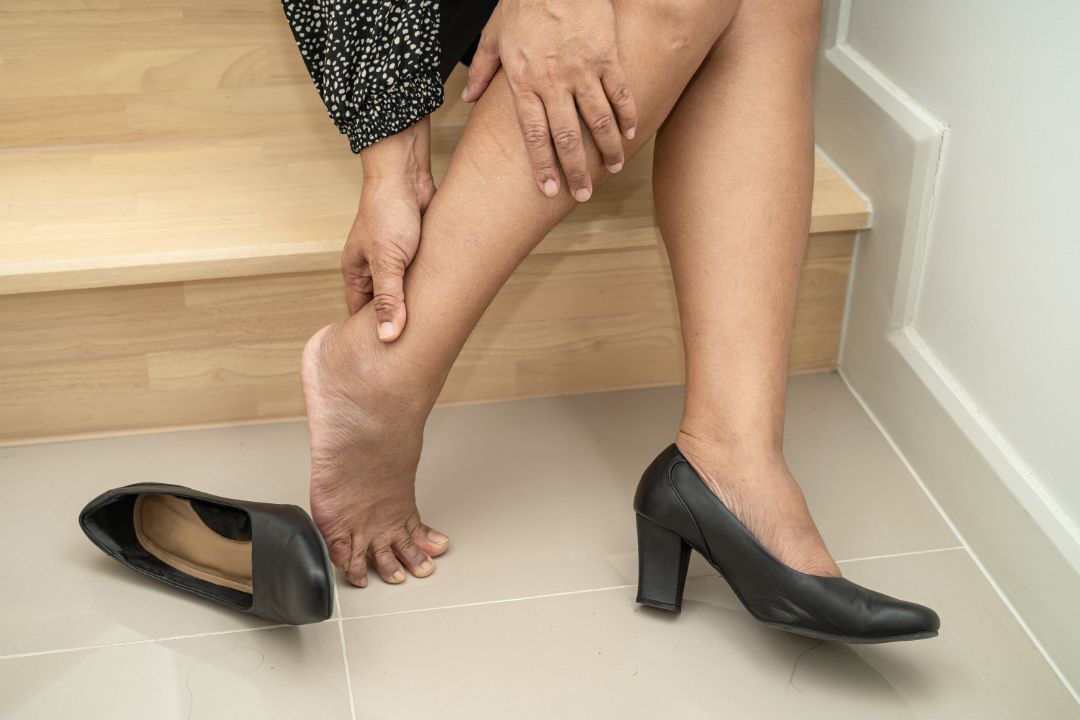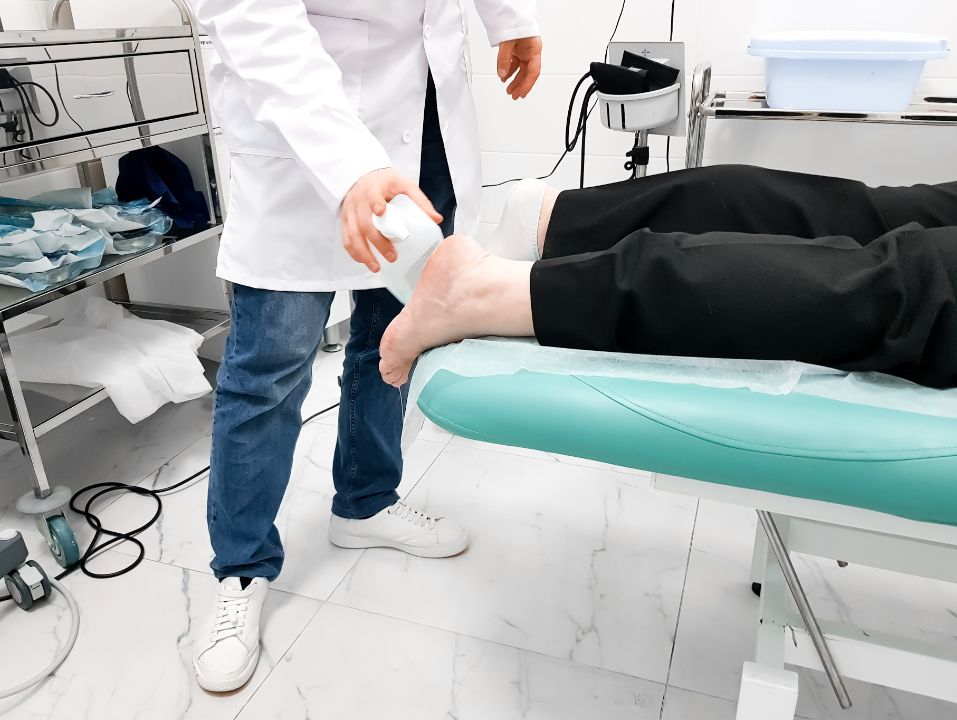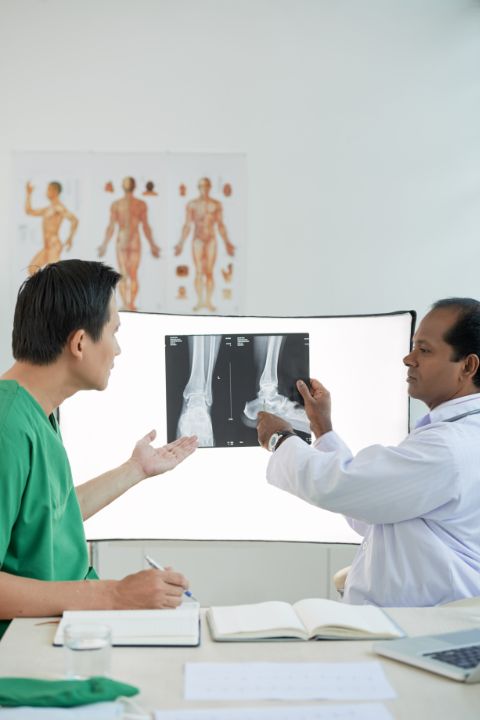Retrocalcaneal bursitis is a condition characterized by inflammation of the bursa located between the back of the heel bone (calcaneus) and the Achilles tendon. This results in pain and swelling at the back of the heel. Here is an in-depth look at the causes, risk factors, symptoms, diagnosis and treatment options for retrocalcaneal bursitis.
What is Retrocalcaneal Bursitis?
- Inflammation of the retrocalcaneal bursa between the heel bone and Achilles tendon.
- Causes pain, swelling and tenderness at the back of the heel.
- Related to repetitive stress, trauma, tight shoes, arthritis and tendon issues.
- Diagnosed based on symptoms and physical exam.
- Treated conservatively with rest, ice, medication, orthotics, and injections.
- Also called insertional or Achilles bursitis.
Understanding what bursitis is helps recognize symptoms and get appropriate treatment.
Heel Bursitis Anatomy: Examing Back of the Heel

Photo Credit: chormail, Envato
- The Achilles tendon attaches the calf muscles to the back of the heel bone (calcaneus).
- The retrocalcaneal bursa lies between the heel bone and the Achilles tendon.
- This fluid-filled sac cushions the tendon to reduce friction during ankle and foot motions.
- Bursitis results when the bursa becomes irritated and inflamed.
Knowing the foot anatomy involved helps us understand why symptoms occur where they do.
Risk Factors: What Causes Retrocalcaneal Bursitis?
Common causes and risks for developing retrocalcaneal bursitis include:
- Repeated stress or friction on the Achilles tendon and bursa.
- Tight calf muscles and reduced ankle flexibility.
- Achilles tendinitis or tendinopathy.
- Running uphill or downhill frequently.
- Sudden increase in athletic training.
- High-heeled, tight-fitting or poorly cushioned shoes.
- Trauma like falling directly on the heel.
- Certain medical conditions like rheumatoid arthritis.
- Older age as tissues lose elasticity.
Avoiding triggers like overuse, tight shoes and trauma helps prevent bursitis.
Symptoms of Retrocalcaneal Bursitis
- Pain in the back of the heel, worse with standing on tiptoes.
- Tenderness when pressing on the back of the heel.
- Swelling, bruising or redness over the Achilles tendon and heel.
- Stiffness and limited ankle flexibility.
- Discomfort when wearing shoes, especially with heel counters.
- Limping or altered gait.
- Difficulty performing activities that load the Achilles tendon.Seek prompt medical evaluation if your heel pain does not improve with rest.
How is Retrocalcaneal Bursitis Diagnosed?

Photo Credit: ira_lichi, Envato
Retrocalcaneal bursitis is diagnosed based on:
- Symptoms of pain, swelling and tenderness at the back of the heel.
- Medical history including activity participation.
- Physical exam assessing foot and ankle range of motion.
- Palpating for tenderness where the Achilles tendon inserts into the heel.
- Imaging like x-ray or MRI to check for bone spurs, arthritis or tendon tears.
There is no single definitive test. Diagnosis relies on recognizing characteristic symptoms and clinical presentation.
Treatment for Retrocalcaneal Bursitis
Treating retrocalcaneal bursitis focuses on relieving pain and inflammation in the back of the heel:
Home Care
- Rest – Avoid activities like running or standing on tiptoes that aggravate symptoms.
- Ice – Apply ice packs to the tender heel area for 15 minutes several times per day.
- Pain medication – Anti-inflammatories like ibuprofen can provide relief.
- Proper footwear – Wear shoes with adequate heel and arch support. Avoid high heels.
- Taping – Taping or splinting the Achilles tendon may help offload it.
Medical Treatments
- Orthotics – Custom orthotic inserts take pressure off the inflamed bursa.
- Physical therapy – Stretching, strengthening, modalities like ultrasound or iontophoresis.
- Steroid injection – Injected into the bursa or around the Achilles tendon insertion site.
- Shockwave therapy – Breaks up calcifications and stimulates healing.
- Surgery – Rarely done as a last resort for chronic bursitis. Involves removing inflamed bursa or bony spur.
Following doctor-recommended treatments improves recovery outlook. Surgery is very uncommon.
Rehabilitation Exercises
Some beneficial rehab exercises include:
- Calf stretches – Gently stretching the calf helps maintain Achilles tendon flexibility.
- Eccentric heel drops – Dropping heels off a step strengthens the Achilles tendon.
- Isometrics – Sub-maximal pain-free contractions strengthen calves.
- Massage – Loosens calf muscles and helps break up adhesions.
- Low-impact training – Cycling and swimming maintain fitness without loading.
Avoid painful stretching or loading the Achilles tendon early in recovery. Progress gradually under your doctor or physical therapist’s guidance.
Prevention Tips

Photo Credit: DragonImages, Envato
Methods to help prevent retrocalcaneal bursitis:
- Perform regular calf stretching and exercises to maintain flexibility.
- Increase training levels slowly with adequate rest between sessions.
- Wear proper fitting shoes with cushioning and arch support.
- Tape or brace the Achilles tendon during sports using a heel lift.
- Treat any foot biomechanical issues like overpronation.
- Use ice after exercise to minimize Achilles and heel inflammation.
Being proactive helps avoid Achilles and heel pain from repetitive overuse and strain.
Long-Term Outlook
With appropriate treatment, most cases of retrocalcaneal bursitis resolve within 6-12 months. Some people have flare-ups especially if underlying causes like poor footwear are not addressed. Wearing proper shoes, maintaining calf flexibility and avoiding overloading the Achilles tendon keeps symptoms at bay. Surgery to remove the inflamed bursa may be considered for chronic cases if all else fails but is rarely needed. Being patient through the rehabilitation process leads to the best recovery results.
FAQs
How do you treat retrocalcaneal bursitis?
Treatment for retrocalcaneal bursitis often includes rest, ice application to reduce swelling, and over-the-counter anti-inflammatory medications to reduce pain. Stretching exercises for the Achilles tendon and calf muscles, shoe inserts, or custom heel wedges can also be beneficial. A doctor may recommend further interventions if symptoms persist after several weeks of home treatment.
How long does it take for retrocalcaneal bursitis to heal?
The healing timeline for retrocalcaneal bursitis varies depending on the severity of the condition and the effectiveness of treatment. With conservative treatment, including rest and physical therapy, symptoms often improve within a few weeks. However, severe cases may require longer healing times.
What are the signs symptoms of retrocalcaneal bursitis?
The primary symptom of retrocalcaneal bursitis is pain at the back of the heel. This pain may become worse during physical activity or when wearing tight-fitting shoes. Other symptoms can include swelling and redness around the heel and ankle, and increased pain when standing on tiptoes.
How is retrocalcaneal bursitis caused?
Retrocalcaneal bursitis is usually caused by overuse or repetitive strain on the Achilles tendon, often from activities like running or jumping. It can also result from wearing poorly fitting shoes that rub against the heel. Other possible causes include injuries to the heel, rheumatoid arthritis, and other inflammatory conditions.


